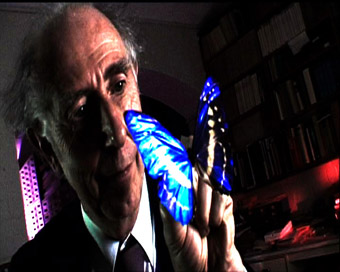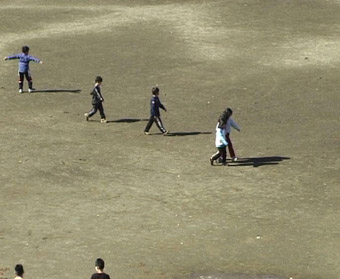reeldance festival: global shorts, this dancing life
jane mckernan

Butterfly Man, Samantha Rebillet
The opening night of the ReelDance International Dance on Screen Festival began with a parody lecture and short film demonstration by Double The Fist. We were told there were two elements to dance film—a. dance, and b. film—and shown examples. There was the experimental dance film, the camera-as-dancer film and the narrative dance film, where employer and employee negotiated the intricacies of a workplace agreement through dance. It was a warm welcome into the world of ReelDance.
Most of the films in this opening program were less overt in their use of dance than films in other festival sessions. The theme was everyday dance. Interestingly, this theme led the films to share another common element–dancing men. There was scarcely a woman on screen.
Alexei Dmitriev's Dubus (Russian, 4mins) created a montage of moving bodies from the black and white worlds of Casablanca, Citizen Kane and film musicals of the early 40s, edited to dance forwards and backwards to a swing soundtrack. The rhythm of the editing—catching singers, orchestras and dancers swinging between action, never quite moving forward—gave the film's performers the appearance of a surging almost maniacal group enthusiasm for the pursuits of late night nightclub music and dancing.
Butterfly Man (Australia, 6mins) by Samantha Rebillet was restrained in its introduction of dance. This documentary style film, a portrait of butterfly collector Don Herbison-Evans, opens with still shots of the interior of his home, with live butterflies abounding on his bedspread and ones that had been ‘sent to heaven’ in the fridge and freezer. Herbison-Evans talks about the process of collecting as the film follows him to the Macleay Museum, where his collection is kept, and back home again. Here he tells us that he himself was like a butterfly, having blossomed at fifty when he discovered his love of dance. At this point, the camera reveals picture rails laden with trophies. We see Herbison-Evans resplendent in a pink satin shirt, practising his dance moves in the lounge room. He is clearly a man who could be labelled eccentric, and it would have been possible for the film to patronise or make fun of his passions. However, the filmmaker deftly steps around this, as exemplified in the closing scene where Herbison-Evans, elegant and dignified, waltzes with his partner, There is real pleasure in watching him guide her across the floor.

Dancing Boy, Marjan Laaper
There are more eccentric men, touched by the call of Elvis, in Brenin/King (director Margaret Constantas, UK, 14mins). Three men make their way through the heather of the Welsh countryside, rock and roll moves jerking out of their bodies, to join a male choir singing Elvis songs in Welsh, atop a craggy hill. There they make a slow motion dance joining together classic ‘King’ poses while answering questions from the choir posed to these 'reincarnations' of Elvis. The ritual over, the men make their way back down the hill. Brenin/King is a beautiful looking film, with the strange actions of the men juxtaposed against the expansive Welsh landscape. But after the authenticity of Butterfly Man, the clear composition of this fiction, made me feel the filmmakers were a little too aware of the quirk factor in their subjects.
An uneasy feeling lurks beneath the simple surface of Night Practice (UK/Sweden, 3mins) by Susanna Wallin. One teenage boy runs a lap around an oval, while a group of other boys practice breakdance moves in the centre, on the grass and on a large high jump mat. The field is made artificially day bright by huge floodlights, flaring the pale blue of the running track. In the distance, there is the sound of traffic and sirens. The running boy looks to the centre group as he runs, and a smaller boy pedals his bike across the field. The final scene has the smaller boy lying across the running track, laughing and feeding lollies into his mouth, interrupting the graceful run of the older boy.
The program also had two films from Norway, Waltz (Zoe Christiansen,10mins) and Shall We Dance? (Martin Lund, 9mins), which made different uses of social dance, and Oru Divasum (Australia, 5mins) in which director Paul Blackman performs fluid hip hop moves against a background of bemused Indians in Chennai.
The film that stayed with me longest, however, was the very simple Dancing Boy by Marjan Laaper (Netherlands, 2mins), which is exactly as the program described it: “a boy spinning across a field, the screen and out of frame.” There is such joy in his moving and his having a body that can spin, that the 'dance' is at once everyday and quite extraordinary.
Global Shorts #01: This Dancing Life, May 15, ReelDance International Dance on Screen Festival, Sydney, May 11-18
RealTime issue #85 June-July 2008 pg. web






